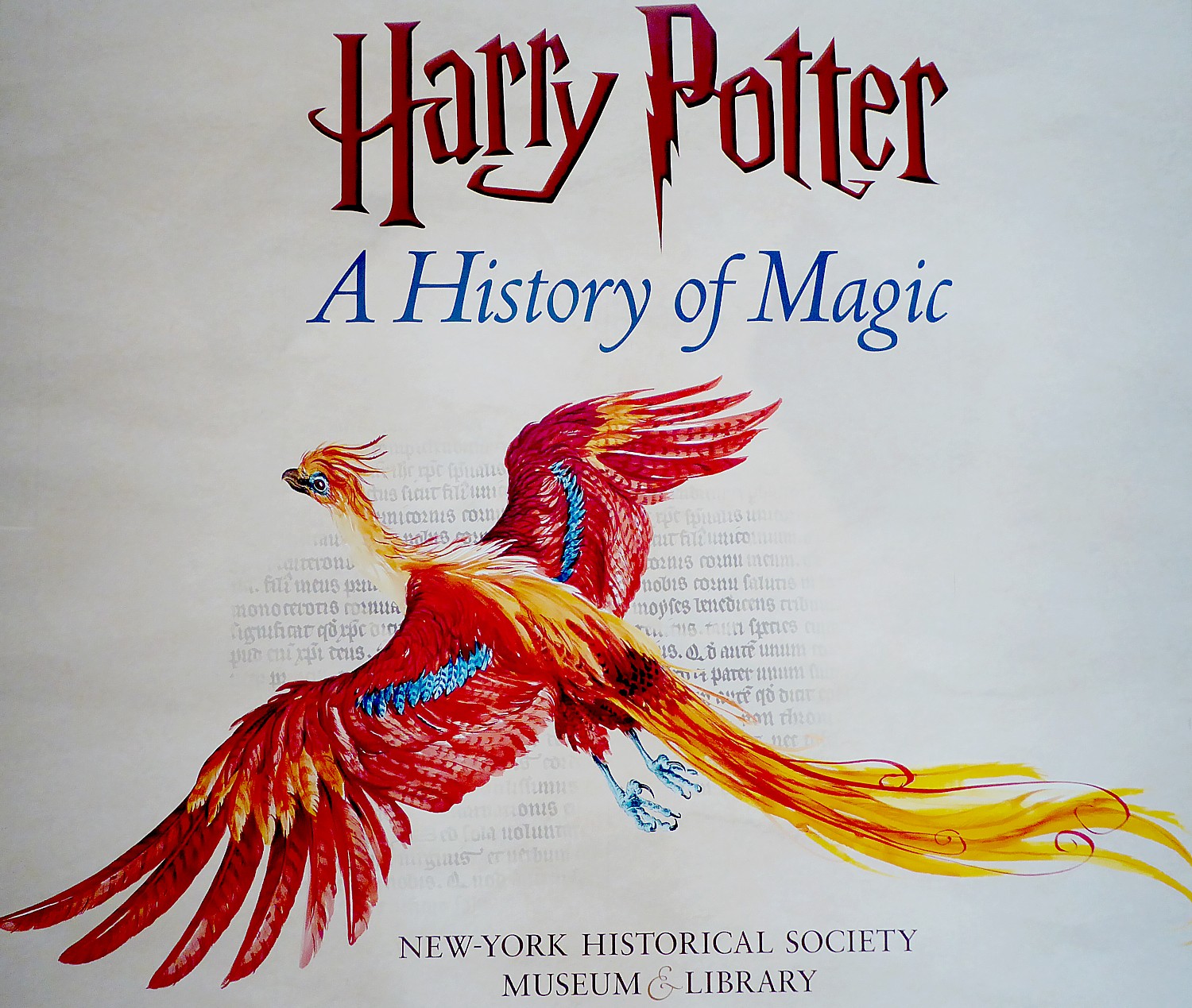
by Karen Rubin
Travel Features Syndicate, goingplacesfarandnear.com
“Harry Potter: A History of Magic”, the newly opened exhibit at the New-York Historical Society Museum & Library only on view until January 27, is a must-see on so many levels. It isn’t just for fans of J.K. Rowling’s phenomenal series, where you get extraordinary insights into her creative process through glimpses at original hand-written drafts and drawings, but insights into the history of magic – the centuries of folklore, myth and legend – that provided the foundation for her stories. Here you see the original documents and artifacts which make you realize (for the first time), how Rowling drew on history and tradition, and how magic and witchcraft actually provided the foundation of science and discovery.
“Abracadabra,” we learn, is an incantation believed to have healing powers, first recorded by Quintus Serenus Sammanicus, physician to the Roman Emperor Caracalla. He prescribed that the word be repeatedly written out, each time leaving off one letter. The charm was then worn as an amulet around the neck to drive out fever. We see it described in “Liber Medicinalis,” a 13th century book from Canterbury.
The invisibility cloak that Harry Potter wore? There actually was an incantation for invisibility that we can see in a mid-17th century spell book owned by a contemporary of Shakespeare. A 4th century papyrus scroll turns out to be an ancient Greek handbook of magic that contains a love charm.
Mandrake roots really do look like men (or women) and the legend of them screaming when pulled out by the roots, causing insanity, was documented across cultures. We get to see a mandrake root, which looks like a shriveled old man in anguish.
The Philosopher’s Stone that plays such a key role for Harry Potter (it was renamed the Sorcerer’s Stone for American readers)? This was the quest of alchemists, who sought to create the elixir of immortal life and turn ordinary metal into gold – in essence, harnessing the energy of the universe and its power. The “recipe” for the Philosopher’s Stone was believed to be prescribed in The Ripley Scroll. We get to see an actual Ripley Scroll, from around 1570 England, exquisite in its color, unfurled over 20 feet, one of only 22 known to still exist. This one is on loan from the Beinecke Rare Book and Manuscript Library at Yale University.
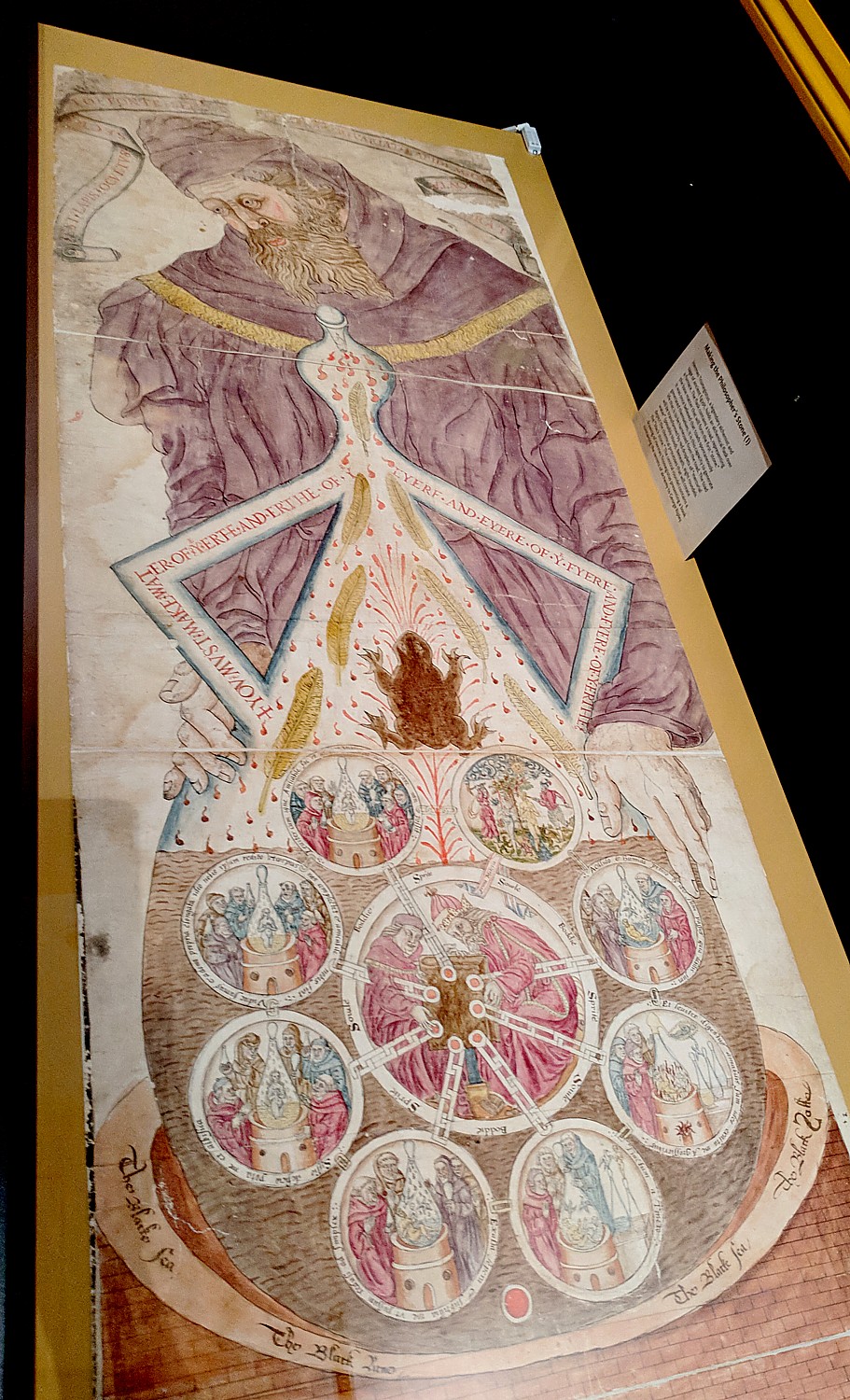
The scroll takes its name from George Ripley, a canon at Bridlington Priory in northern England and author of “The Compound of Alchymy.” The scroll, full of mystical symbolism, supposedly gives clues to how to make the key red, white and black stones that together would form the Philosopher’s Stone. Rowling wove these symbols into her characters: Rubeus Hagrid (rubeus is Latin for “red); Albus Dumbledore (albus is Latin for “white”) and Sirius Black, Harry’s three father figures.
We get to see a copy of Culpepper’s Herbal, describing the medicinal properties of herbs, the first medical text to be published in English (instead of Latin), so as to break the monopoly of wealthy, educated in having this knowledge. Culpepper was accused of witchcraft in 1642, but acquitted. The book is still in print and we learn from Rowling that she possesses two copies.
We get to see the actual tombstone of Nicolas Flamel, an actual person! who a landlord and bookseller in medieval Paris who married a rich woman and became a philanthropist. His interest in alchemy, according to Pottermore, was apparently sparked after he obtained a mystical book was written by a man called Abraham the Jew in Greek, Hebrew and other languages. Following his death in 1418, rumors began to circulate that Flamel was an alchemist who had discovered how to make the Philosopher’s Stone, and turn metal into gold. He was buried in the church of Saint-Jacques-de-la Boucherie in Paris, his grave marked by this tombstone. But years later, when the body was exhumed, there was no body. Some believe he escaped to India, and with the elixir, still lives.
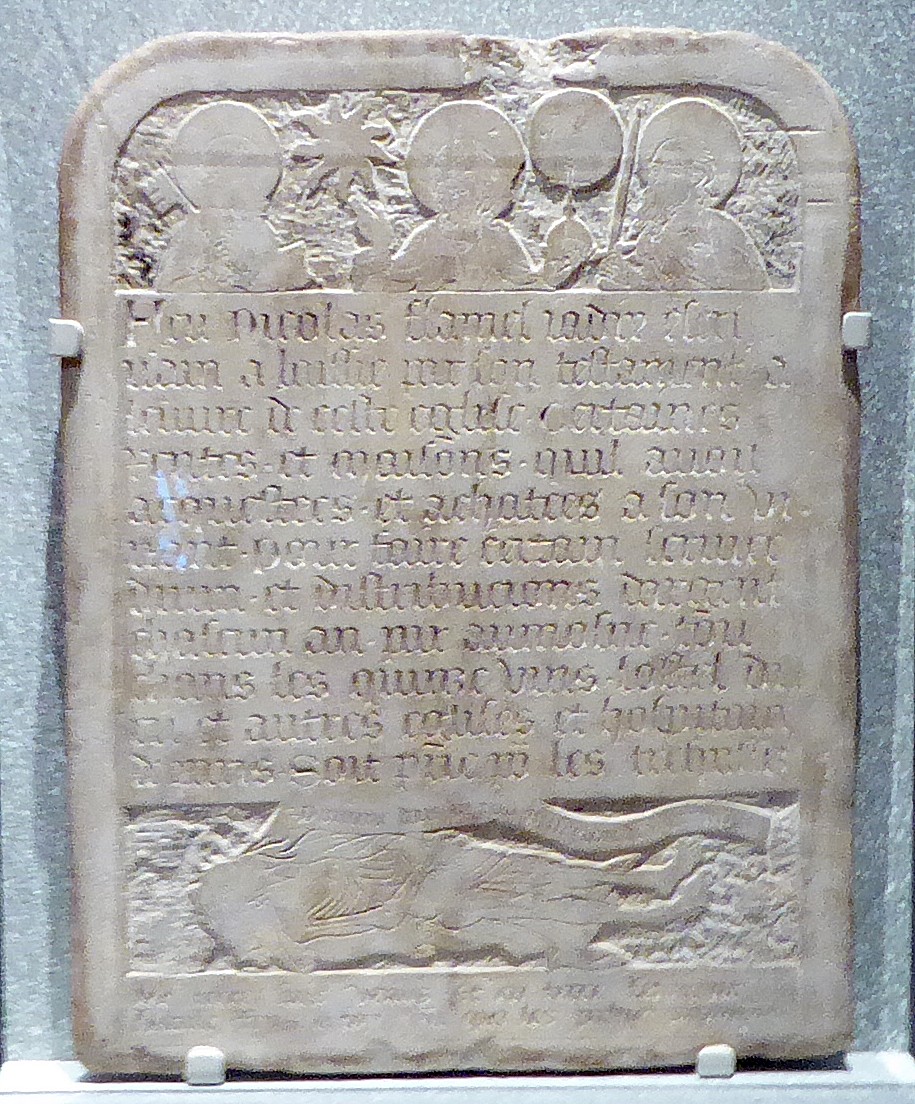
The exhibition, a cerebral celebration marking the 20th anniversary of the US publication of Harry Potter and the Sorcerer’s Stone, captures the traditions of folklore and magic at the heart of the Harry Potter stories. Based on Harry Potter: A History of Magic, a British Library exhibition, with some special New York twists, it combines century-old treasures—including rare books, manuscripts, and magical objects from the British Library, New-York Historical Society, and other collections—with original material from Harry Potter’s U.S. publisher Scholastic and J.K. Rowling’s own archives, never before collected in one place, and items that have never been shown before. And this exhibit is the only other place where it will be shown, before the items go back to their respective museums, which include the Museum of Witchcraft and Magic, in Cornwall.
The entertaining aspect is in the exhibition’s presentation, as if you are wandering through Hogwarts, with the galleries organized around the Hogwarts’ curriculum for witches: Potions, Alchemy, Herbology, Charms, Astronomy, Divination, Defense Against the Dark Arts, Care of Magical Creatures – each one showing the historical and cultural traditions that underlie Rowling’s fantastical world and her creative process.
It is as if instead of J.K. Rowling inventing the Hogwarts curriculum, she graduated from it. It also means that all of us, children and adults, who were so enrapt in the Harry Potter saga of witchcraft and magic 20 years ago, have a whole new dimension for appreciating Rowling’s masterpiece from a mature perspective.
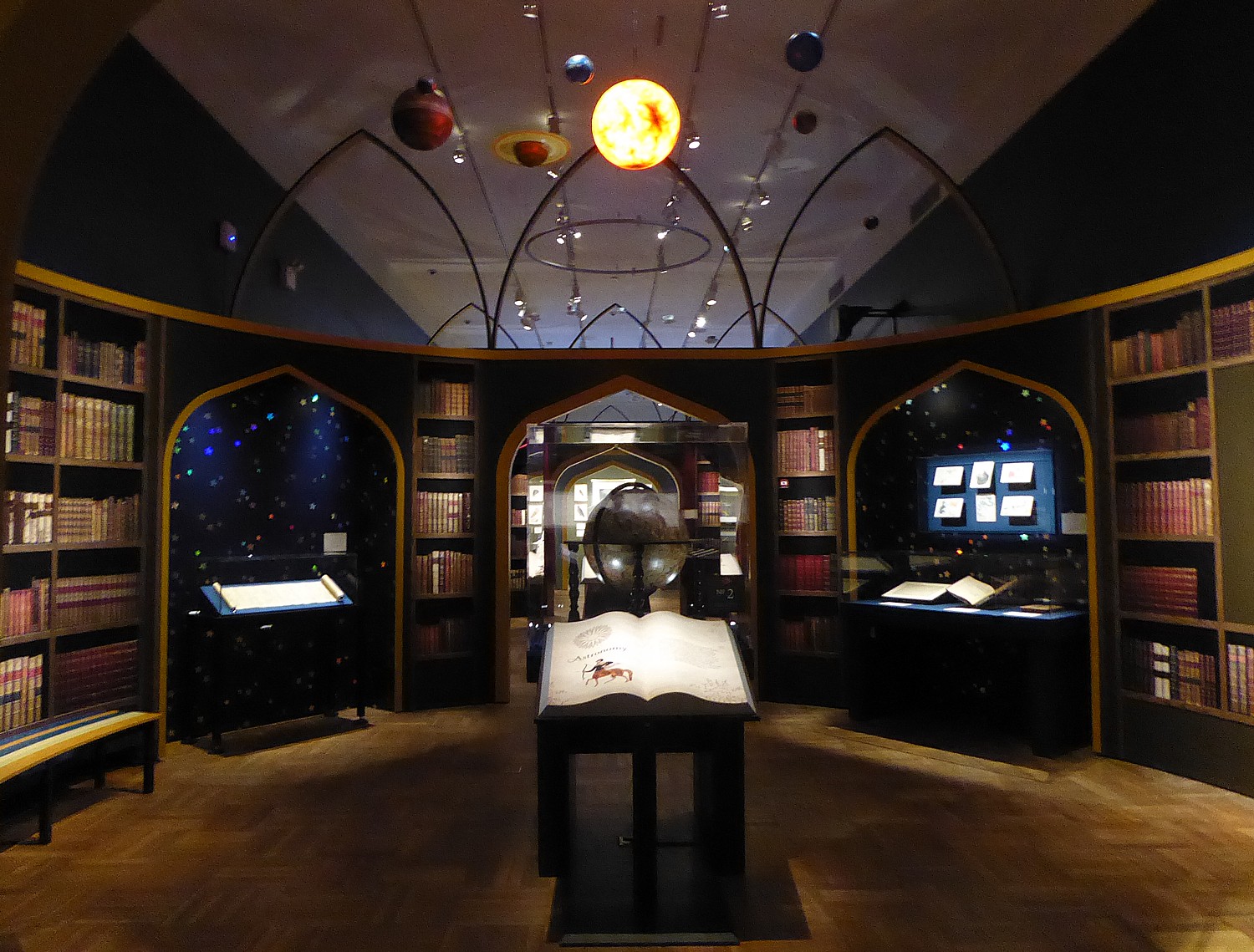
The exhibit is captivating on so many levels – Rowling’s personality and creative process, you get so many insights into her as a person, and the connection to history and tradition at the heart of mythology. Also, we get to see the evolution of science from magic and spiritualism.
Rowling faithfully represented these traditions – even the names she chose for her characters relate back to these traditions, symbolically or literally.
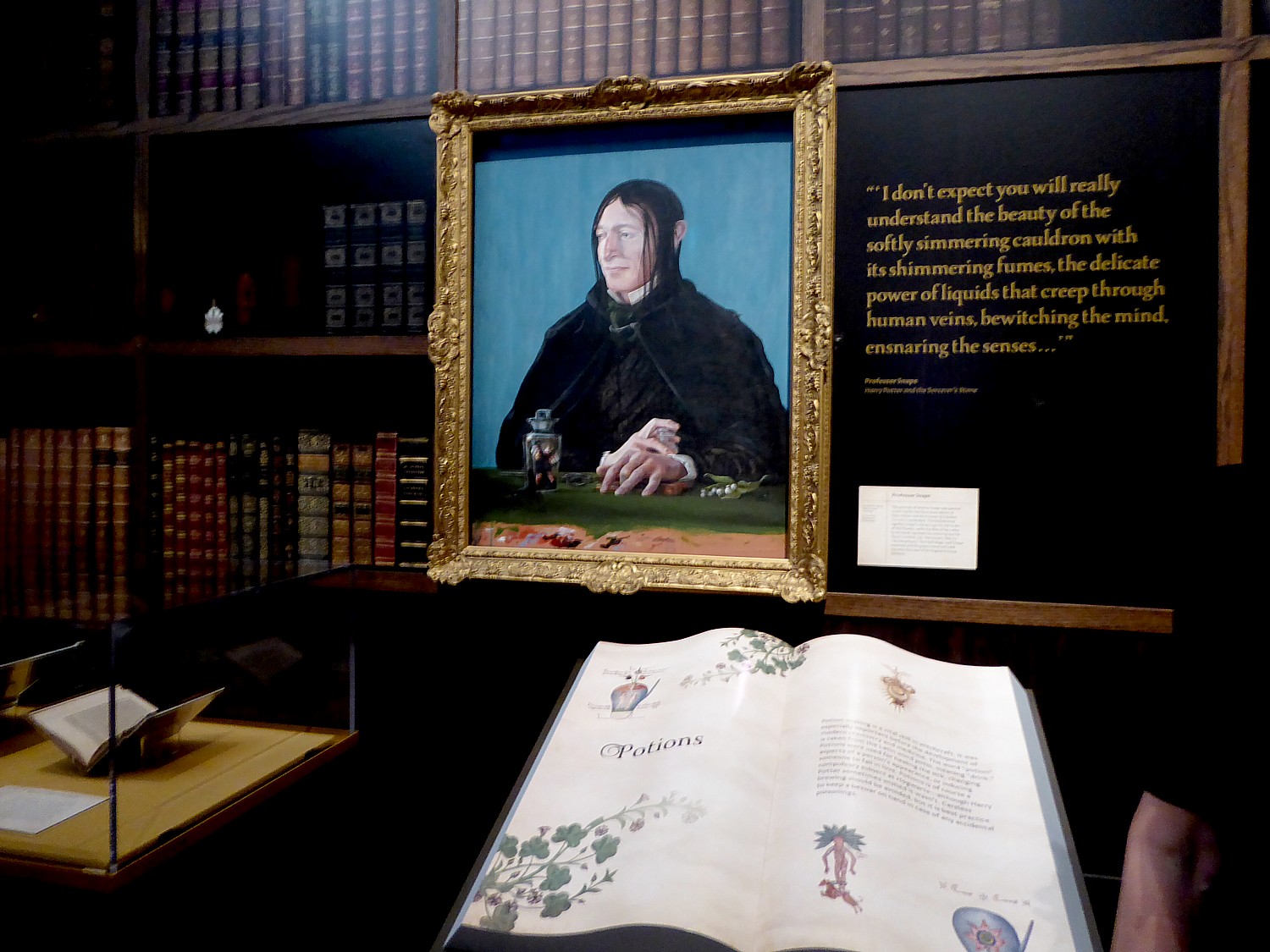
In Potions & Alchemy, we see a copy of Jacob Meydenbach’s 1491 edition of Hartus Sanitatis (Latin for “The Garden of Health”), the first printed cyclopedia of natural history, which actually includes a hand-colored woodcut illustration of a potions class.
One of the plants described, blue hellebore, was the plant Harry Potter forgot to add in his Draught of Peace.
We see an actual bezoar stone, which was believed to be an antidote to poison, first introduced into medieval Europe by Arab physicians. They were expensive to buy and owners often kept their stones in elaborate cases. Here we see a bezoar stone in a gold filigree case from the 17th century.
The Herbology section is particularly fascinating: Here we see an illustration from a 15th century illustrated herbal by Giovanni Cadamasto that describes mandrakes (mandragara) that could cure headaches, earache, gout and insanity. Just as Rowling depicted, the plant was said to be particularly hazardous to harvest because the shrieks from the roots cause madness. “The best way to obtain it safely was to unearth its roots with an ivory stake, attaching the plant to a dog with a card. A horn would sound, drowning out the shrieking, startling the dog and causing it to drag out the mandrake.” We actually get to see a mandrake root and how much it resembles a prone shriveled man who appears anguished. The description of mandrake is also from a 14th century Arabic text, originally in Ancient Greek by Pedanius Dioscorides, a botanist.
We see implements of “magical gardening” of bone and antler, on loan from the Museum of Watchcraft & Magic, Boscastle, Cornwall.
There is an original copy of a book by Elizabeth Blackwell (one of the first women physicians), “A Curious Herbal,” published in London in 1737-38. She was desperate to raise money to spring her husband Alexander from debtor prison, so made drawings that she took to Alexander to identify, which she then published weekly, eventually detailing 500 plants.
An 1807 edition of Robert John Thornton’s “The Temple of Flora,” an elaborate botany book that nearly bankrupted Thornton to produce (it was originally titled, “The New Illustration of the Sexual System of Linnaeus”). There is an illustration of Dragon arum (Dracunculus vulgaris), also known as stink lily, which reproduces the smell of putrefying meat to attract flies for pollination.
In Charms, we see a copy of Cotton Mather’s “The Wonders of the Invisible World,” published in London in 1693 (from the New-York Historical Society Library), in which he justified the Salem witchcraft trials.
This is the area which gives some attention to the way witches were depicted, when in essence, they were shaman, healers, who were extraordinarily connected to the natural world, and in fact, the first scientists and doctors.
We see the earliest printed illustration of a witch, from 1489, depicting witches as powerful and dangerous. “The Iconography went on to influence image of witches for centuries. The printing press was new – like video of the time.”
Here we see a colorful broomstick belonging to Olga Hunt, a 20th century witch of Manatan, Devon (from the Museum of Witchcraft, Boscastle). The broomstick is closely associated with the Western image of witches, but has roots in pagan fertility rites. The connection with witchcraft and broomsticks developed during the witch hysteria of 16th and 17th century Europe. Olga was supposed to have used it to leap around Dartmoor on a full moon.
We also see Rowling’s original, handwritten draft of the Sorting Hat Song, sung at Harry’s sorting ceremony in his first year, with some crossings out and additions, and her sketch of Argus Filch, the Hogwarts caretaker (Argus is a name from Greek Mythology of a man-eyed giant who is “all seeing.”)
In Divination, there is a major archaeological find on view: oracle bones some 3,000 years old from China that proved the existence of the Shang Dynasty, which had only been known in legend. The bones offered not only the earliest examples of Chinese writing, but showed that the culture worshipped ancestors – the Oracle Bones were a means of communicating with ancestors, who could send back messages.
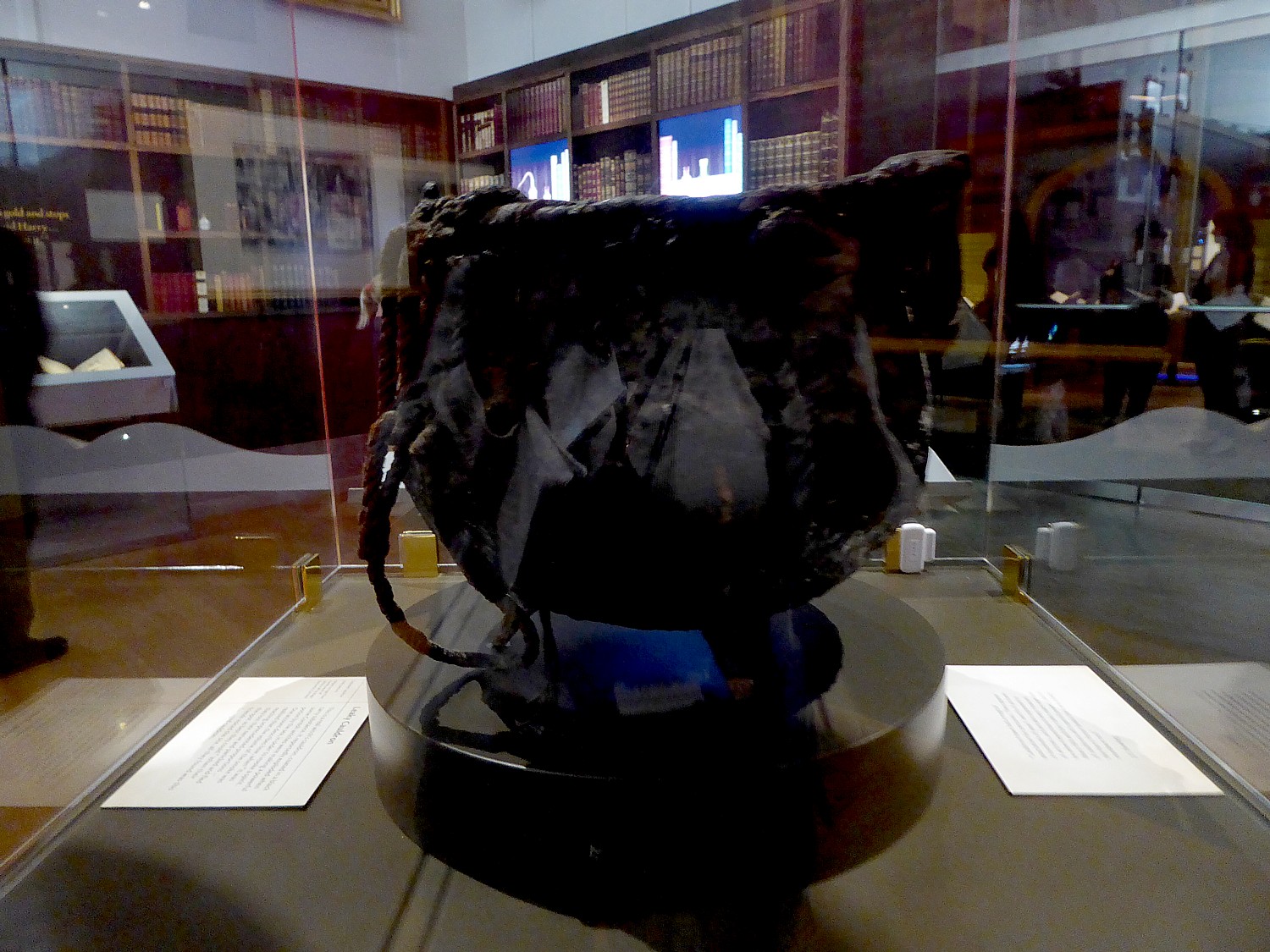
We see a black moon crystal ball used by “Smelly Nelly,” a 20th-century British witch who used strong perfume to attract the spirits she believed helped her to see the future (on loan from Museum of Witchcraft & Magic, Cornwall). Nelly is reflected in Rowling’s character of Sybill Trelawney, Hogwarts Divination professor.
There is also a 19th century fortune-telling doll from New-York Historical’s collection.
Astronomy features a 1699 celestial globe by famed cartographer Vincenzo Coronelli, pages from a notebook compiled by the artist and inventor Leonardo da Vinci that show the sun and moon revolving around the Earth, and a 13th century astrolabe thought to be one of the oldest geared instruments in existence, from the American Museum of Natural History Library.
Defense Against the Dark Arts features an actual wand, in the shape of a snake (snakes were magical because they were thought to have the ability to regenerate, and a wand in the shape of a snake would have been very powerful), and we learn that there are still wandmakers today who go to the woods where trees speak to them to be selected. There is also a magic staff (1998) carved from timber.
The basilisk in mythology didn’t look like the snake-like creature in Harry Potter but was depicted as a strange chicken, the size of palm, but its stare would kill you, and the way to defeat it was not by sword but by weasels.Care of Magical Creatures features a 13th-century bestiary manuscript depicting a phoenix rising from the ashes, a narwhal tusk, and John James Audubon’s original watercolor of snowy owls, just like the snowy owl that Hagrid gave to Harry Potter.
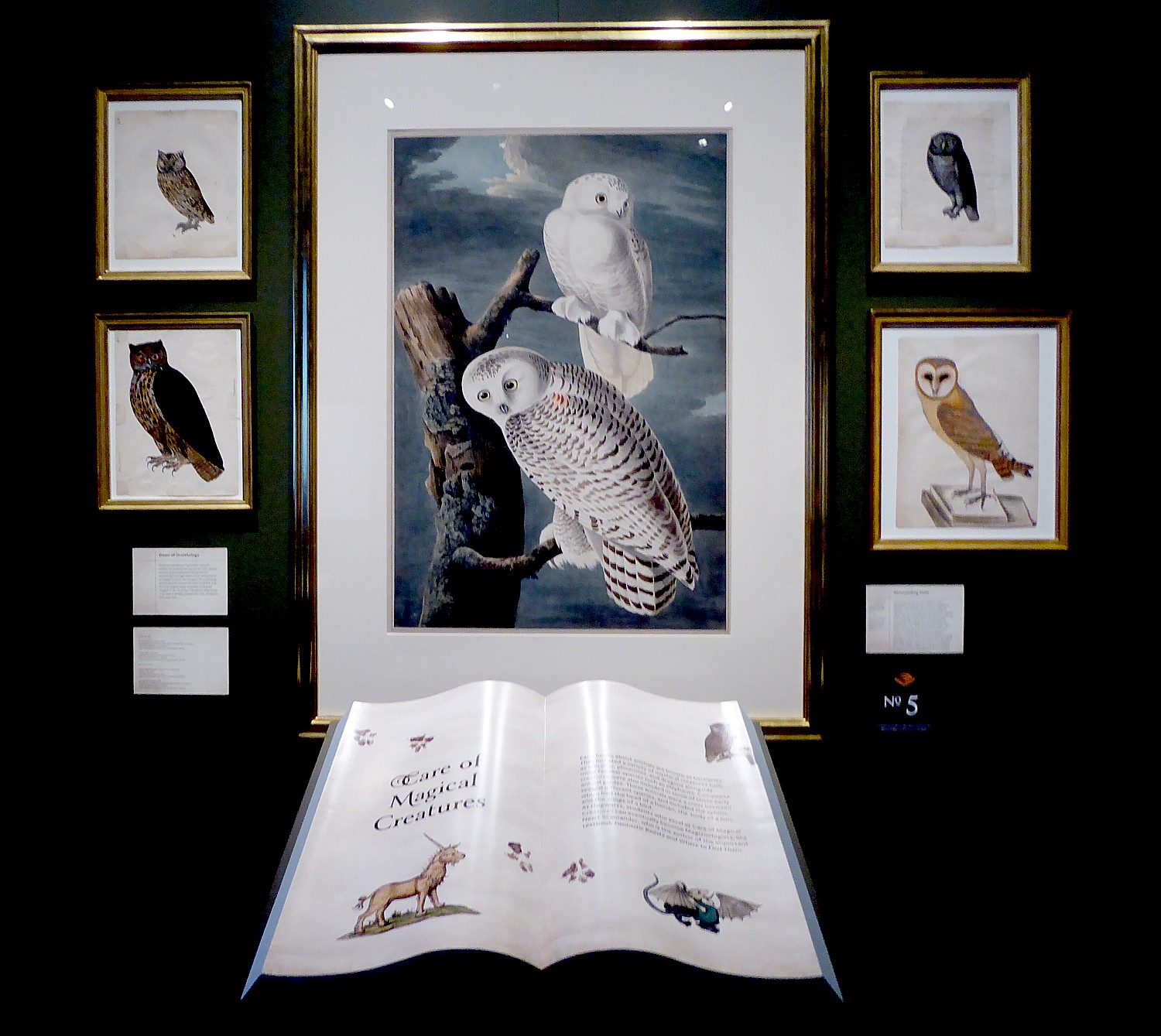
We see the oldest description of a Hippogriff: 16th century book on vellum paper given to George III –a magical creature that has the front legs, wings, and head of a giant eagle and the body, hind legs and tail of a horse. It is very similar to another mythical creature, the Griffin, with the horse rear replacing the lion rear.
We see examples of unicorn (loaned from the Explorer’s Club), as well as an actual merman – a Japanese creation made by combining two fish with wire and cloth (worthy of P.T. Barnum). This is the first time it has been displayed outside the United Kingdom.
This fascination with these strange new creatures reflects the era of exploration into strange new lands and discovery of new creatures.
This section features Rowling’s hand-written draft of “Deathly Hallows”, with her crossings out, notes to self and ”x” where she needed to add more providing this amazing insight into Rowling’s creative process. There is also her own illustration of Harry and Hagrid going to Gringots and Jim Kay’s drawing of Hagrid.
These items were collected for the exhibition, basically tracing and providing original artifacts that underlie Rowling’s Harry Potter narrative, but it seems as if Rowling had already undertaken the Hogwarts curriculum herself. The exhibit brings together the source material that informed her inspiration.
In the section, Past, Present and Future, one of the most fascinating items is Rowling’s own draft for the “Order of Phoenix” and her meticulous outline of plot and where the characters are, what they are doing. You see original cover art by Brian Selnick for the 2018 (20th anniversary) series, in which he unifies the seven covers as a single image that tells the story of the Boy Who Lived, which had never been displayed before, and models of set designs for the “Cursed Child” on Broadway, as well as an autographed screenplay of “Fantastic Beasts,” and an edition of “Harry Potter and the Philosopher’s Stone” (as “Sorcerer’s Stone” was titled in United Kingdom).
The New York presentation of the British Library’s Harry Potter: A History of Magic exhibition is special because it features Mary GrandPré’s pastel illustrations for the cover artwork of Scholastic’s original editions of the novels; Brian Selznick’s newly created artwork for the covers of the 20th anniversary edition of the Harry Potter series published by Scholastic; cover art by Kazu Kibuishi featured in Scholastic’s 15th anniversary box set; and the enormous steamer trunk used to transport a signed copy of Harry Potter and the Half-Blood Prince on the Queen Mary to the U.S. The exhibition also includes costumes and set models from the award-winning play Harry Potter and the Cursed Child.
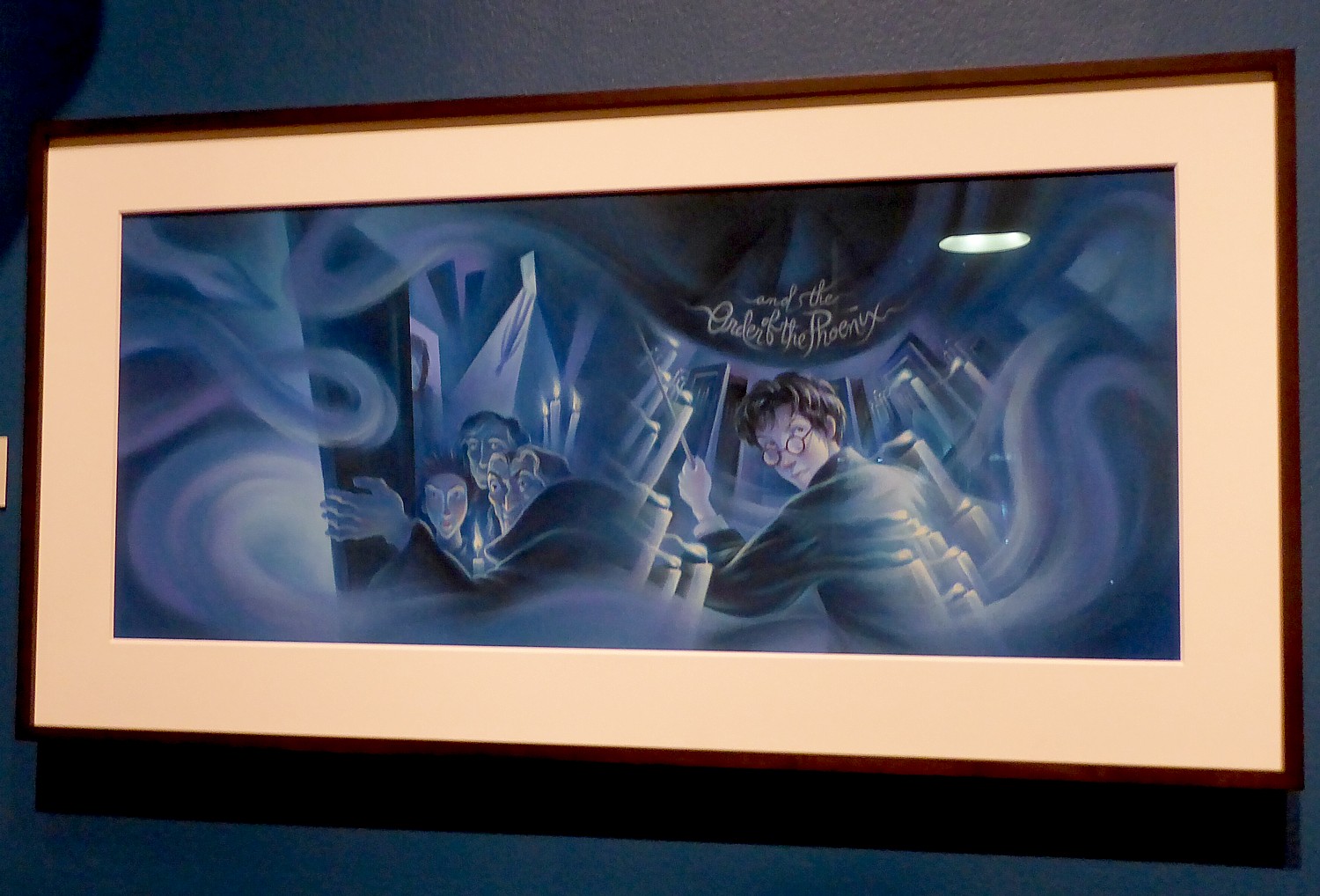
Also on display for the first time in the U.S. are Rowling’s handwritten first drafts of The Philosopher’s Stone and Deathly Hallows, her hand-drawn sketch of the Hogwarts grounds, and portraits and sketches of some of the Hogwarts’s professors and magical creatures created by British illustrator Jim Kay. John James Audubon’s watercolor of Snowy Owls, a 1693 publication defending the Salem witch trials, a study of the Woolworth Building—the landmark New York location featured in the film Fantastic Beasts—and other artifacts from New-York Historical’s collection.
I love the origination story – worthy of fiction – how in 1990, J.K. Rowling was sitting on a delayed train from Manchester to London when an idea popped into her head fully formed: the character of Harry Pottery, a boy wizard with messy black hair, glasses and a lightning shaped scar on his forehead. Over the next five years, she planned out seven books, writing mostly in longhand and amassing a mountain of notes, many on scraps of paper (some we get to see).
She presented a scroll of the draft of “Harry Potter and the Philosopher’s Stone” (as it was titled in the United Kingdom), to Nigel Newton of Bloomsbury, who handed it to his eight year old daughter, Alice, to read. His daughter’s review, “‘it’s probably one of the best books for 8 or 9 year old could read,” encouraged him to publish. The initial print run was just 500 copies, typical for a children’s book by a first-time author. The book turned into a worldwide phenomenon – over 500 million books sold, printed in 80 languages. We see various editions lining the corridor.
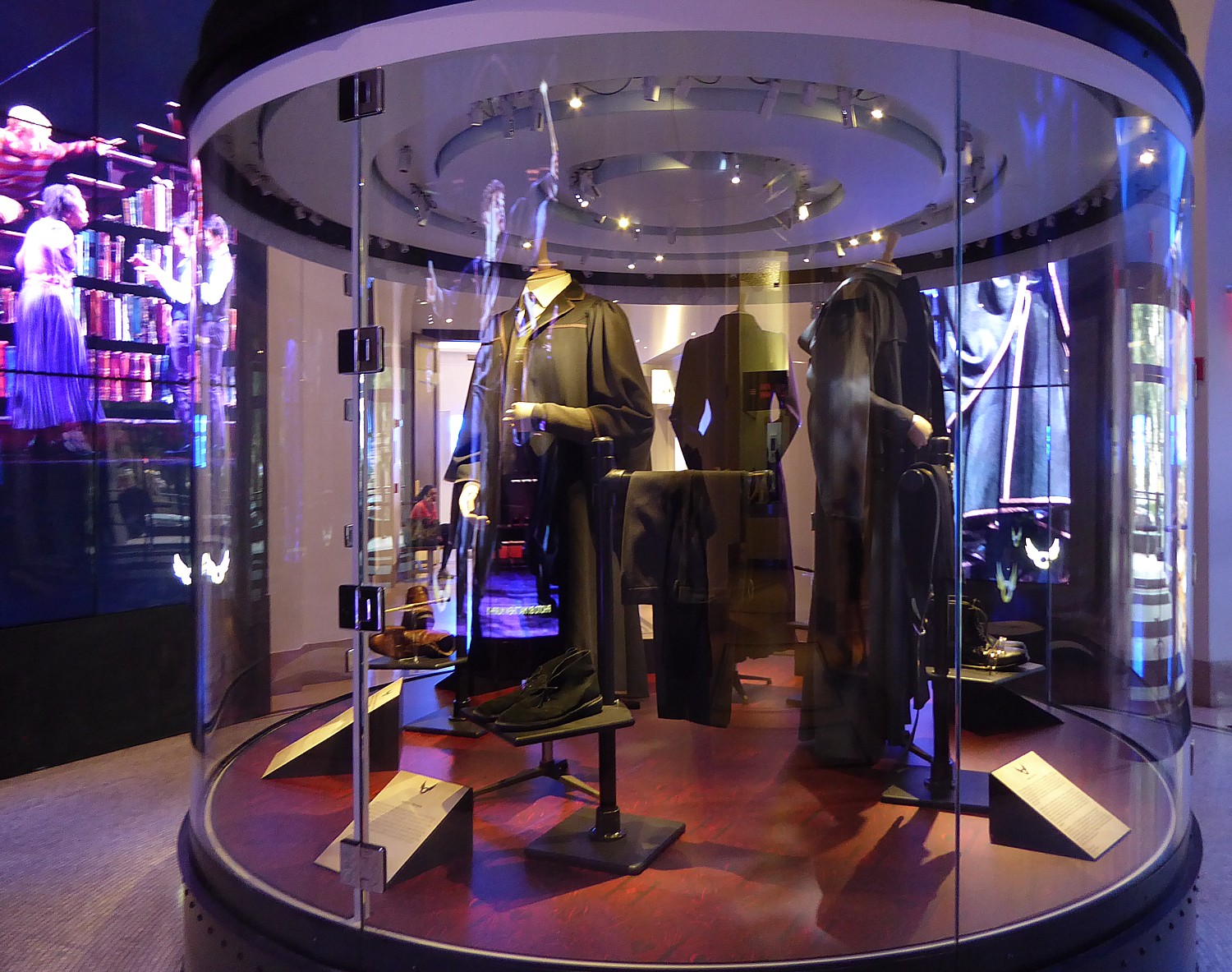
There’s so much to absorb – I went through the exhibit twice, and used the Audible guide they make available for free, and after three hours, could have spent considerably more time there.
There is a superb Family Guide for “A History of Magic” that turns the exhibit into an interactive activity.
New-York Historical is also presenting a wide variety of exhibition-related events for grown-up Harry Potter fans throughout the run of the exhibition, including trivia nights, art workshops, creative writing classes, social meet-ups, open mics, book clubs, and engaging courses that explore the Hogwarts curriculum. Programs include an onstage conversation with illustrators Mary GrandPré and Brian Selznick, and a special evening with actor Jim Dale, known for his narration of all seven Harry Potter U.S. audiobooks. Family activities feature History of Magic family days with hands-on activities and crafts, a Harry Potter family book club, historical Hallowe’en celebration, and trivia for families. Additional programming information is available at harrypotter.nyhistory.org.
Harry Potter: A History of Magic is sponsored by Audible and a special audio tour to accompany the Harry Potter: A History of Magic exhibition at New-York Historical, featuring Natalie Dormer, will be available to ticketholders as a free Audible download, offering in-depth content on fascinating objects throughout the exhibition galleries.
This is the only other exhibition of this collection outside of the British Library. After finishing here on January 27, the artifacts will be returned to the museums and institutions to which they belong. Poof, it’s vanished.
Timed-entry tickets for the exhibition Harry Potter: A History of Magic are $21 for adults, $16 for seniors (65+), $13 for students, $6 for kids ages 5–13, and free for children ages 0–4; tickets include admission to the rest of the Museum. Harry Potter: A History of Magic is on view through January 27, 2019, on Tuesday, Wednesday, Thursday, and Saturday 10 am–6 pm; Friday 10 am–9 pm; and Sunday 10 am–5 pm. The last entry is 45 minutes before closing.
Visit harrypotter.nyhistory.org to purchase exhibition and programming tickets in advance.
Black Citizenship in the Age of Jim Crow
“History Matters,” is the New-York Historical Society’s motto, and that is clearly on view.
There is so much to see at the New-York Historical Society – it never fails to offer fascinating and provocative exhibits – you need a couple of extra hours beyond the time visiting “Harry Potter.” I went through “Black Citizenship in the Age of Jim Crow” exhibit which is hard-hitting and in your face discussion of how the Emancipation Proclamation, Civil War, and most significantly, the assassination of Abraham Lincoln, led to an institutionalized system of terror and subjugation of African Americans, including a series of Supreme Court decisions dating back to Dred Scott, that perpetuated subjugation (on view through March 3).
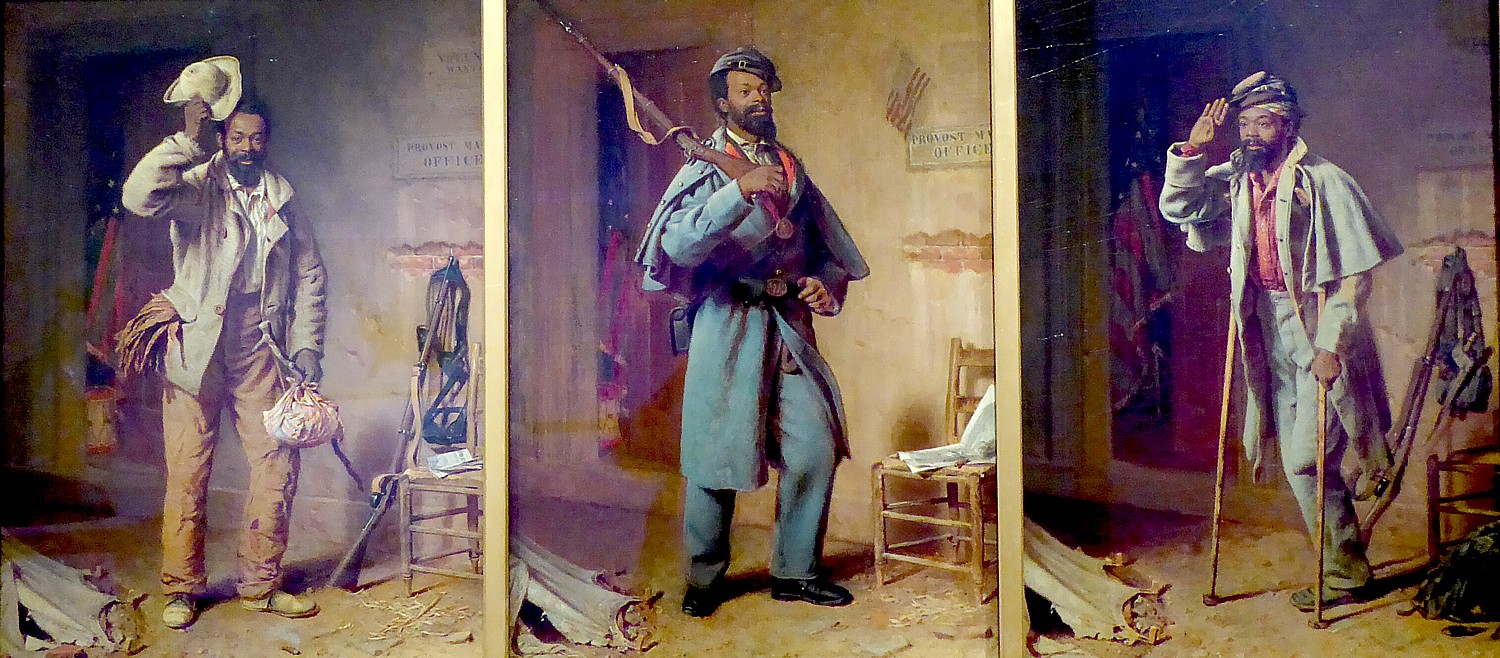
Also, the relatively new “Gallery of Tiffany Lamps” is not to be missed – this permanent display of 100 illuminated lamps is breathtaking for its beauty and exquisite presentation (by architect Eva Jiricna), and you even get the opportunity to design your own Tiffany lamp shade. You also learn the “hidden history” behind the lamps: about Clara Driscoll, the woman who up until now was virtually unknown and unheralded but was the artistic genius behind many of his designs, who headed the “Women’s Glass Cutting Department.”
There are also two films that are shown in a fantastic theater, each shorter than 20 minutes: “We Rise” about women and social movements that were incubated, flourished and pollinated from New York City (narrated by Meryl Street) and “New York Story,” how and why it grew to be the commercial and cultural capital of the world and remains inextricably connected to the world.
There is a lovely café at the Society.
New-York Historical Society, 170 Central Park West (at 77th Street), 212-873-3400, nyhistory.org.
_____________________________
© 2018 Travel Features Syndicate, a division of Workstyles, Inc. All rights reserved. Visit goingplacesfarandnear.com, www.huffingtonpost.com/author/karen-rubin , and travelwritersmagazine.com/TravelFeaturesSyndicate/. Blogging at goingplacesnearandfar.wordpress.com and moralcompasstravel.info. Send comments or questions to FamTravLtr@aol.com. Tweet @TravelFeatures. ‘Like’ us at facebook.com/NewsPhotoFeatures
